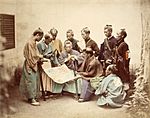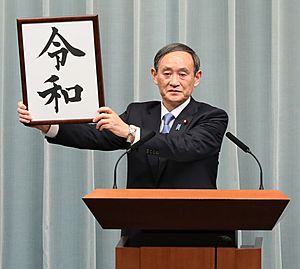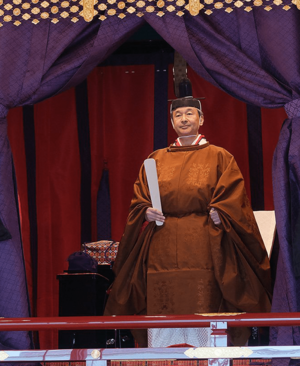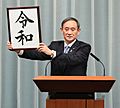2019 Japanese imperial transition facts for kids
 |
|---|
|
The 2019 Japanese imperial transition was when Emperor Akihito of Japan stepped down from his role on 30 April 2019. He was 85 years old and had been Emperor for 30 years. This was a very rare event, as no Japanese Emperor had stepped down since 1817!
When Emperor Akihito stepped down, the Heisei era ended, and the Reiwa era began. His oldest son, Naruhito, became the new Emperor. Many celebrations took place for this important change. The main ceremony where Emperor Naruhito officially took his place happened on 22 October 2019.
Contents
Why the Emperor Stepped Down
Background Story
In 2010, Emperor Akihito told his advisors that he wanted to retire one day. However, nothing happened right away.
Then, in July 2016, a national TV station reported that the Emperor wished to step down. He wanted his oldest son, Crown Prince Naruhito, to take over in a few years.
At first, officials said there was no official plan for the Emperor to retire. This was because the Imperial Household Law, which sets rules for the Imperial Family, did not have a way for an Emperor to step down.
On 8 August 2016, the Emperor gave a special TV speech. He talked about his old age and how his health was not as good. People understood this as a hint that he wanted to retire.
New Laws for Retirement
Because the Emperor wanted to step down, the government started to work on new laws. They formed a group of experts to discuss how an Emperor could retire.
In January 2017, lawmakers began talking about the idea of the Emperor stepping down.
On 19 May 2017, a new bill was created to allow Emperor Akihito to retire. On 8 June 2017, the National Diet (Japan's parliament) passed this bill into law. This was the first time the Imperial Household Law had been changed since 1949!
The law allowed the government to plan for the change. Emperor Akihito officially stepped down on 30 April 2019. After he retired, he received the new title of Emperor Emeritus. His wife, the Empress, became Empress Emerita.
Planning the Change
On 1 December 2017, the Imperial Household Council met. This group had not met in 24 years! They met to set the dates for the ceremonies. This was the first time in 200 years that power was being transferred this way.
The council includes important people like the Prime Minister and leaders from Japan's parliament and Supreme Court. They decided the date for the change.
Chief Cabinet Secretary Yoshihide Suga explained that the date was chosen carefully. It allowed the old Emperor to celebrate his 30th year on the throne. It also happened during Golden Week, a big holiday period. This made the change a happy, well-planned festival instead of a sad event.
Finally, on 8 December 2017, the government created a special committee. This committee was in charge of all the events. They wanted to make sure everything went smoothly for the Japanese people.
Preparing for the Big Day
The special committee met in January 2018. They announced that a plan would be released on 3 April. Official farewell celebrations for Emperor Akihito began on 12 February 2019.
Golden Week, 2019
The government made Golden Week a special ten-day holiday in 2019. It lasted from 27 April to 6 May. This was done to mark the Emperor's retirement and the new Emperor's start. Japanese law says that if a regular workday is between two national holidays, it also becomes a public holiday. This helped create the long break.
New Calendar Era

Since 1867, a new Japanese era usually starts the day after an Emperor dies. But this time, Emperor Akihito was stepping down while still alive. This was new!
Calendar makers and software companies needed to know the new era's name ahead of time. This way, they could prepare new calendars and systems.
The new era name, Reiwa, was announced on 1 April 2019. Chief Cabinet Secretary Yoshihide Suga shared the name during a TV press conference.
Enthronement Ceremony
The official ceremony for Emperor Naruhito to take the throne happened at the Imperial Palace in Tokyo. This was on 22 October 2019, and it was an extra holiday.
Many important guests attended, including Japanese politicians and over 3,000 other officials. More than 120 leaders from other countries and many delegates from about 210 countries were there.
The ceremony started early in the morning with a private ritual. The Emperor, dressed in white, visited a special sanctuary in the palace.
At 1 pm, the main part of the ceremony began. Emperor Naruhito wore traditional clothes called sokutai, and Empress Masako wore a jūnihitoe. They sat on the tall Takamikura throne. The Emperor gave a speech, saying he would be a symbol for the country. After his speech, Prime Minister Shinzo Abe gave a congratulatory speech, and everyone cheered.
Guests at the Ceremony
Representatives from about 174 countries attended the ceremony. These included royal family members and leaders from around the world. Emperor Naruhito also hosted a special dinner later that day.
Many members of the Japanese Imperial Family were present, including:
- The Crown Prince and Crown Princess Akishino, who are the Emperor's brother and sister-in-law.
- Princess Mako and Princess Kako of Akishino, the Emperor's nieces.
- The Emperor's sister, the Former Princess Nori.
- His aunts and uncles, like Prince and Princess Hitachi.
Some close family members were not there, including:
- The Emperor Emeritus Akihito and Empress Emerita Michiko, the Emperor's parents.
- The Princess Toshi, the Emperor's daughter.
- Prince Hisahito of Akishino, the Emperor's nephew.
Celebration Parade
A parade to celebrate Emperor Naruhito's enthronement took place on 10 November. Tens of thousands of people gathered in Tokyo, waving Japanese flags.
The Emperor and Empress rode in a special convertible car. Other important people, like Crown Prince Fumihito and Prime Minister Shinzō Abe, followed in other vehicles. The parade route was about 4.6 kilometers (3 miles) long, going from the Imperial Palace to the Emperor's residence.
Timeline of Events
Heisei Era
- 2010: Emperor Akihito tells his advisors he wants to step down eventually.
- July 2016: News reports say Emperor Akihito wants to retire.
- 8 August 2016: The Emperor gives a TV speech hinting at his wish to retire.
- September 2016: Prime Minister Shinzo Abe creates a committee to study the legal side of the Emperor stepping down.
- 19 May 2017: A bill is introduced to allow Emperor Akihito to retire.
- 9 June 2017: The bill allowing the Emperor to step down becomes law.
- 1 December 2017: The Imperial Household Council meets and approves 30 April 2019 as the date for the Emperor to step down.
- 8 December 2017: The government officially approves the date and creates a committee to plan the ceremonies.
- January 2018: The planning committee meets for the first time.
- 3 April 2018: The committee releases its official plan for the ceremonies.
- 8 January 2019: Official farewell celebrations for Emperor Akihito begin.
- 1 April 2019: The new Era name, Reiwa, is announced.
- 30 April 2019: Emperor Akihito officially steps down. He becomes the first Jōkō (Emperor Emeritus) since 1840. The Heisei era ends.
Reiwa Era
- 1 May 2019: The Reiwa era begins, and Naruhito becomes the new Emperor.
- 22 October 2019: The official Enthronement Ceremony for Emperor Naruhito takes place.
- 10 November 2019: A parade is held to celebrate Emperor Naruhito's enthronement.
- 8 November 2020: Prince Akishino is officially named kōshi (a rank like Crown Prince).
Important Ceremonies
Many ceremonies took place during this special time. Some were private, meaning only a few people were there. Others were public, for everyone to see.
- 12 March 2019: Private ceremonies where Emperor Akihito reported his abdication (stepping down) to the sun goddess and his ancestors at the Imperial Palace.
- 15 March 2019: Private ceremonies where imperial messengers reported the abdication at important shrines and mausoleums (burial places).
- 26 March 2019: The Emperor and Empress visited the mausoleum of Emperor Jimmu, Japan's first Emperor.
- 18 April 2019: The Emperor and Empress visited the Ise Grand Shrine, a very important shrine.
- 23 April 2019: The Emperor and Empress visited the mausoleum of Emperor Akihito's father, Emperor Shōwa.
- 30 April 2019: The Taiirei-Seiden-no-gi ceremony. This was the public ceremony where Emperor Akihito officially announced his retirement. It happened in the Pine Hall of the Tokyo Imperial Palace.
- 1 May 2019: The Kenji-tō-Shōkei-no-gi ceremony. Emperor Naruhito received the Imperial Regalia (sacred treasures) and seals. This was a public ceremony.
- 1 May 2019: The Sokui-go-Chōken-no-gi ceremony. Emperor Naruhito met with representatives of the people for the first time as Emperor. This was also public.
- 22 October 2019: The Sokuirei-Seiden-no-gi ceremony. This was the main public ceremony where Emperor Naruhito officially proclaimed his enthronement. Many guests from Japan and other countries attended.
- 10 November 2019: The Shukuga-Onretsu-no-gi ceremony. This was the public parade where the Emperor and Empress rode in a car to greet the people.
- 14–15 November 2019: The Daijōsai ceremony. This was a very important private ritual where the Emperor offered new rice to the gods and prayed for the country.
Images for kids
-
Chief Cabinet Secretary Yoshihide Suga announces the new Imperial era "Reiwa" to the press.





